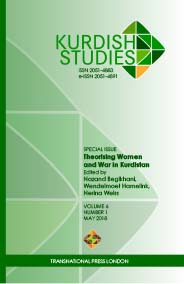The representation of post-conflict gender violence in Iraqi Kurdish novelistic discourse in Bahdinan
The representation of post-conflict gender violence in Iraqi Kurdish novelistic discourse in Bahdinan
Author(s): Lolav M. Hassan AlhamidSubject(s): Gender Studies, Ethnic Minorities Studies
Published by: Transnational Press London
Keywords: Kurdish women; post-conflict gender violence; Kurdish novelistic discourse; Bahdinan;
Summary/Abstract: This article explores the processes of finding a voice, learning to speak, and breaking silence around gender violence for a Kurdish woman endeavouring to resist oppression and destroy forced negative images and identities. It examines the ways in which she struggles to break imposed silences through resisting gender discrimination and telling stories of violence and exploitation, as represented in the Kurdish novelistic discourse in Bahdinan. Studying Sabri Silevani’s Mariama: Kiçe-Jinek ji Zemanek Di (Mariama: A Woman from Another Time, 2007), the article examines the various forms and layers of violence imposed on Kurdish women by the tribal and patriarchal norms and the social and political structures within the post-conflict Kurdish society in Iraqi Kurdistan. The three-fold typological model of violence developed by the political scientist Johan Galtung is adopted in the article to explore the ways in which the personal characteristics of individuals and the political, economic, and cultural structures of society are viewed as factors affecting the generation of gendered aggression. Most importantly, for the purpose of this article, is the significant utilisation of the association of Galtung’s typology with feminist studies of violence in the exploration of Kurdish women’s attempt to resist marginalisation and their struggle for recognition. Moreover, Rita Felski’s description and study of modern writing by women as a medium through which female political identities and collective consciousness are constructed and represented are adopted to discuss the structural and thematic properties of the text.
Journal: Kurdish Studies
- Issue Year: 6/2018
- Issue No: 1
- Page Range: 31-57
- Page Count: 17
- Language: English

